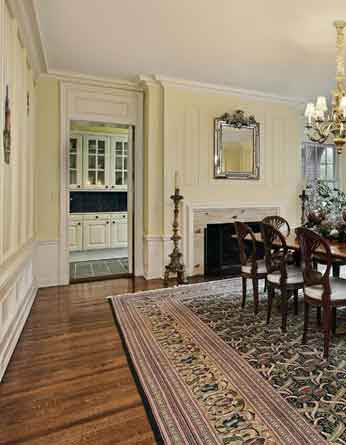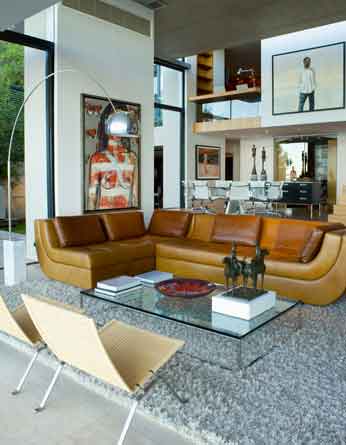Area Rug Styles
It goes without saying that you should follow your style sense when choosing something as critical as an area rug. Any floor covering in your home impacts interior beauty, design, décor, comfort, livability, and upkeep. It’s a fact that floor coverings can make or break a home. Because of the number of area rug choices including patterns, colors, textures and price points, choosing an area rug can intimidate even the most experienced shopper. Knowing the basic types of area rugs can provide you with a firm foundation upon which to begin your shopping journey.
Persian Rugs
- Most diverse styles worldwide
- Over fifty different Persian styles are woven in Iran and other countries such as India, Pakistan, China, and some European countries
- A true Persian Rug is one that is hand-knotted in Iran, formerly called Persia, and features a border to emphasize the main pattern
- Several other narrower borders may also be part of the design
- Don’t be fooled by borderless imitations
- Date back to the fifth century BC
- Considered an investment and keepsake
- Sometimes passed down through generations
Oriental:
- Recognized for warmth and intricate designs
- Handmade rather than mass produced
- Known to be extremely durable and long lasting
- They are often made from natural fibers such as wool, silk or cotton and become works of art you will cherish for years to come.
- Will not find antique oriental rugs made of synthetic blends
- The pattern changes direction without warning
- Comes from India, western China, Central Asia, Iran, the Caucasus or Turkey
Chinese:
- Designs are very literal rather than decorative
- Most motifs have very exact meanings
- Motifs on Chinese rugs are stand alone
- Traditional Chinese rugs are recognizable by their simple, classic motifs and unusual colors
- Often feature a center, circular medallion; natural objects such as animals, flowers, and clouds; stylized Chinese ideographs; or entire scenes
- Usually framed with a simple, wide border and many display contrasting colors
- High quality and extremely durable
Turkoman:
- Produced by nomadic weavers of Turkmenistan, Uzbekistan, Afghanistan and the province of Khorassan in northeast Iran
- Easily distinguished by a dominant red to red-brown background color, geometric pattern, and a unique octagonal motif known as gul (Persian name for flower)
- A layout is generally all-over and guls are repeated in rows with smaller guls of similar, geometric designs (minor guls) in between the rows of major guls
- White, beige, black and blue are used to create color contrast in the motifs and the border of the rug
Caucasian:
- Woven by tribal weavers of the region south of Russia, near the Caucasus Mountains, between the Black and Caspian Seas
- Patterns are geometric
- Designs tend to be stripes, crosses, squares, diamonds, hexagons, triangles, botehs, 'S' shapes (derived from old dragon designs), geometric-animal figures and human figures
- Common characteristic- positioning of similar shapes in different sizes next to one another
- Colorful bright palette
- Colors of blue, red, purple, yellow, green, navy, black and beige can be combined in one rug
Tibetan
- Distinguishing characteristics are vivid colors, huge and few motifs, and plain, dominant backgrounds
- Motifs are woven in red, orange, pink, yellow, beige, blue, green and white
- Background colors are usually blue, black, red, orange, and less frequently, yellow or ivory
- Designs are influenced by Chinese and East Turkestan styles
- Designs can be geometric or curvilinear
- Different types: medallions, flower and rosettes, mythological animal and birds, geometrical designs, and rugs used in monasteries for ceremonial purposes
- Known for depth and richness achieved through subtle variation of color and texture
- Woven exclusively with Nepalese wool-characteristically flexible, strong, lustrous and springy
- Bold eclectic patterns and coloration and rich texture
- Unique primitive sophistication
Indian
- Strongly influenced by those of Iran, mainly by the curvilinear styles
- Popular designs of the 18th and 19th century, which Indo-mir is an example of, were mainly all over the layout with very small floral motifs such as plants, palmettes, rosettes and leaves
- Often the same motifs repeated through the rug
- Borders similar to the motifs in the field
- Not much color contrast
- Colors were mostly well coordinated to suit Western taste
- Brownish red was the dominant color
- Light and dark green and burnt orange also popular
Native American:
- Weaving mainly associated with Navajo wool blankets
- Blankets are flat weaves
- Blankets date back to the late 18th century
- Navajo fabrics are woven on reservations in northern Arizona
- Original styles consisted of stripes and simple geometric shapes
- Four types of Navajo weaving: the Chief blankets, Serape blankets, Eye Dazzler weavings, and fabrics after 1890
- Horizontal stripes with wide stripes and minor stripes at each end of the blanket and a wide strip in the center
- Wide end and center stripes were colored in red and brown; sometimes blue was added
- White and brown stripes woven between the wide center and end major stripes
East Turkestan:
- Rare
- Environmentally friendly
- Prior to the Chinese occupation in 1878, the area in western China above Tibet was called East Turkestan
- Area no longer called that, but are still labeled as East Turkestan
- Also marketed under “Samarkand” because they used to be traded there
- Main East Turkestan sub-styles include Kashgar, Yarkand, and Khotan
- Still being woven on a small scale
- Layout can be either medallion or all over
- Pattern is mainly geometric and long and narrow
- Common design is the pomegranate and vase, which is a symbol of fertility
- Vase symbolizes Mother Earth and the pomegranate is the fruit growing from Mother Earth
Kilim:
- No two are alike
- Flatwoven textiles
- Made by nomadic peoples in Turkey, Iran, Iraq, Russia, China, Pakistan, India, and Morocco
- Turkish- Mediterranean colors, gold-orange, and turquoise
- Iranian- burgundy, rust, heavy blues, and heavy greens
- Kurdish– brighter, mixed with embroidery
- Used as rugs to cover doors and windows, for their dwellings,
- Used as prayer rugs
- Major part of a bride's dowry
- Females weave each rug
- Each piece contains symbols of the family traditions and tribal identity
- No two handwoven are exactly the same in color and size
3 categories of rugs
Braided
- Practical and beautiful
- Constructed from wool or nylon, chenille and olefin or polyesters
- Can be crafted into any size or shape
- Very durable, hard wearing
- Easy to care for
Flokati
- Referred to as sheepskin rugs
- Made of 100% hand-woven New Zealand wool
- Originated in Greece 1500 years ago
- “Shaggy” look
- Contemporary style with a long pile and natural colors
Naturals
- Made from natural materials including Sisal, Jute, Seagrass, and Bamboo
Sisal
- Strong and versatile
- Fibers come from the leaves of the Agave Sisalana plant that is grown as a renewable resource
- Leaves of the plant produce a thousand fibers
- Fibers range in color from straw yellow to a creamy white
- Spun into yarn and then woven into the carpet
- By itself, tough on the feet
- Can be combined with wool or nylon for a softer feel
- Durable
- Provide sound absorption
- Anti-static
- Naturally insulating
- Fire resistant
- Absorb moisture
- Not recommended for use outdoors or in areas of water inside
Jute
- Woven with a loop or flat construction
- Fibers stripped from their stalks and can be spun into yarn or rope and woven
- Yarn is strong and used as warps in knotted rugs
Seagrass
- Product of the paddy fields of China and India
- Popular choice among designers
- Natural beauty and strength
- Stain resistant
- comes in warm beige tones with undertones of green
- Different patterns available such as Herringbone and Basketweave
Bamboo
- One of the fastest growing plants
- Plentiful in supply
- Strong and beautiful
- Woven from natural bamboo fibers
- Feature natural variations in color
- Offer texture and style in an understated way










